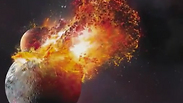
The Giant Impact Hypothesis explains how moon formed
Israeli scientists find answer to mystery behind moon's creation
Scientists from Technion Institute of Technology in Haifa conduct study that provides answer to why earth and moon are almost identical - a question scientists have tried to answer for 30 years.
For years, scientists have believed that the moon was formed after the Earth and a huge object the size of Mars collided about 4.45 billion years ago.
This theory, known as the Giant Impact Hypothesis, was born in the 1970's, but one question has always troubled some scientists – if the moon was formed as a result of this collision, why is its chemical makeup almost identical to that of Earth and should it not also be chemically similar to the other object that was part of its creation?
"In terms of composition, the Earth and moon are almost twins, their compositions differing by at most few parts in a million," Dr. Alessandra Mastrobuono-Battisti, an astrophysicist at the Technion Israel Institute of Technology in Haifa, told Space.com. "This contradiction has cast a long shadow on the giant-impact model."
Dr. Alessandra Mastrobuono-Battisti, an astrophysicist at the Technion, led a group of Israeli scientists in a study that found a way to explain why the Earth and the moon are almost identical.
According to the study conducted at the Technion, the moon resembles Earth so closely because it collided with a large body known as Theia. According to the Israeli scientists, Theia has a similar chemical makeup to Earth, and thus this would explain the discrepancy.
Up until now, scientists believed there was a one percent chance that the Earth and the object it collided with had a similar chemical makeup. But the new study conducted by the Technion scientists, shows that the chances are between 20-40 percent.
As part of the study, the scientists analyzed data from a computerized simulation of 40 "solar systems" in order to determine what the odds would be that stars would be chemically similar to bodies they collide with.
The scientists checked about 85 different stars and more than 1,000 large bodies. The study found that since the stars and the bodies they collide with were formed from similar distance to the sun, they have a similar chemical makeup.
Meanwhile, an American study gives another answer. According to scientists from the University of Maryland, the collision between Theia and Earth was very strong and led to a cloud of debris which, before it sank and developed into the moon, completely "mixed" with an adjacent body.
"On average, impactors are more similar to the planets they impact compared with different planets in the same system,” Mastrobuono-Battisti told Discovery News. “Our study was the first to reconsider this issue, now exploring it with large data and... wide range of models."
The Technion study was published on Friday in the well-regarded science magazine "Nature."
"The surprising and most exiting thing was to found out that we can bring to light a 30-year-long mystery," said Hagai Perets, one of the authors of the study who also works as an astrophysicist at the Technion.













